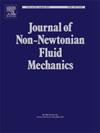Influence of viscoelastic properties on induced charge electro-osmosis of Phan–Thien–Tanner fluids around a metal cylinder
IF 2.7
2区 工程技术
Q2 MECHANICS
引用次数: 0
Abstract
Efficient mixing of chemicals is a key issue in microfluidics because of the limitations of low diffusivity in laminar flow. Induced charge electro-osmosis (ICEO), which generates quadrupole vortices, has been shown to be a simple and effective method for rapid mixing. The aim of this work is to improve the mixing of viscoelastic fluids using ICEO, thus extending the application of microfluidics in biomedical and chemical analysis. A simplified Phan–Thien–Tanner (sPTT) constitutive model was used to characterize the flow properties of the viscoelastic fluid, and the Navier-Stokes (NS) and Poisson-Nernst-Planck (PNP) equations were used to control the potential and ion concentration distributions, respectively. Numerical simulations of ICEO around a polarized cylinder in a two-dimensional cavity filled with an electrolyte solution have been carried out using the finite volume method. The effects of Weissenberg number (Wi), viscosity ratio (β), and extensibility parameter (ε) on the velocity and flow field were investigated. The results show that the larger ε and Wi are, the larger the maximum velocity is, and the peak velocity increases with increasing ε and Wi. When ε increases from 0.01 to 0.8, the peak velocity increases from 23.22 × 10−4 to 31.73 × 10−4. The maximum velocity at Wi = 10 is about twice that at Wi = 0.01.

求助全文
约1分钟内获得全文
求助全文
来源期刊
CiteScore
5.00
自引率
19.40%
发文量
109
审稿时长
61 days
期刊介绍:
The Journal of Non-Newtonian Fluid Mechanics publishes research on flowing soft matter systems. Submissions in all areas of flowing complex fluids are welcomed, including polymer melts and solutions, suspensions, colloids, surfactant solutions, biological fluids, gels, liquid crystals and granular materials. Flow problems relevant to microfluidics, lab-on-a-chip, nanofluidics, biological flows, geophysical flows, industrial processes and other applications are of interest.
Subjects considered suitable for the journal include the following (not necessarily in order of importance):
Theoretical, computational and experimental studies of naturally or technologically relevant flow problems where the non-Newtonian nature of the fluid is important in determining the character of the flow. We seek in particular studies that lend mechanistic insight into flow behavior in complex fluids or highlight flow phenomena unique to complex fluids. Examples include
Instabilities, unsteady and turbulent or chaotic flow characteristics in non-Newtonian fluids,
Multiphase flows involving complex fluids,
Problems involving transport phenomena such as heat and mass transfer and mixing, to the extent that the non-Newtonian flow behavior is central to the transport phenomena,
Novel flow situations that suggest the need for further theoretical study,
Practical situations of flow that are in need of systematic theoretical and experimental research. Such issues and developments commonly arise, for example, in the polymer processing, petroleum, pharmaceutical, biomedical and consumer product industries.

 求助内容:
求助内容: 应助结果提醒方式:
应助结果提醒方式:


